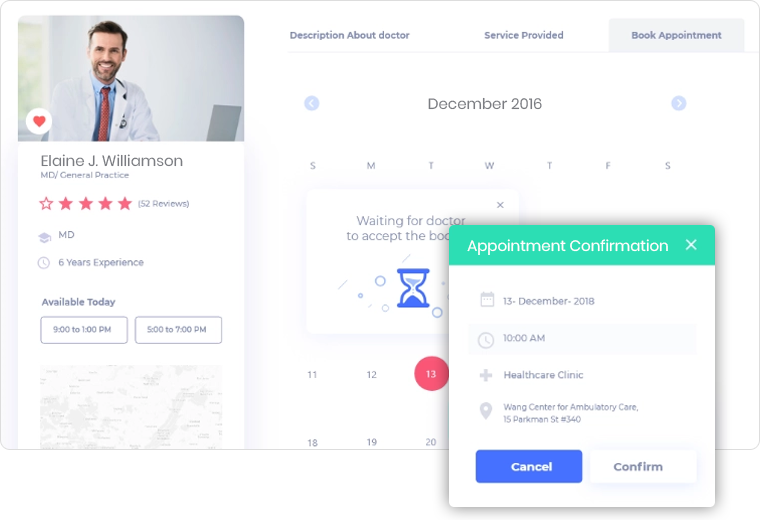
Healthcare Industry is the one which has been highly benefited by being digitalized and took the interaction between patients and physician to a new level. Electronic health record, also abbreviated as EHR, is the software that helps both the parties to reduce paperwork by improving their interactions. EHR has been providing undeniable advantages from improved collaboration, reliable prescription to more efficient health care. Since the software development focuses on exchanging medical records smoothly between various medical practices, the clinicians have welcomed the innovative technology wholeheartedly.
To start with, let’s have a look closely at what more it offers to patients and clinics.
What is Electronic Health Record?

Electronic Health Record, in general, manages and maintains the information that’s typically collected in healthcare providers chart papers: medical histories, diagnosis, test results, allergies, treatment, doctor’s note, etc. In short, we could say, EHR is integrated with more functionalities and is capable enough to streamline healthcare processes. A cloud-based EHR is a new generation, feature-packed, user-friendly platform, and a robust medical application in the global market. The software is helping in simplifying work processes by being paperless and is more about inculcating a tradition of simulated working with intelligent systems that help doctors to work effectively to improve their patient’s care. The software is cost-efficient, fast as well as secure.
Additionally, the EHR has become a tool, with the help of which the family medicine office can quickly transform practices to meet their as well as their patients’ needs. Because of the software, the workflows have been enhanced, and access to information has made the medicine practices more efficient and effective for physicians and their staff as well. EHR offers decision support and has automated reminders which are helping physicians to provide safer and high-quality care to patients and the community. The EHR is about quality, safety, and efficiency, and is an excellent tool for physicians.
Benefits of an EHR System to Healthcare Providers
- Patients data is easily accessible
- Patients files can be marked for drugs recall and for updates
- Seamless chronic disease management
- It provides increased preventative care services
- The enhanced intra-office communication level
- The fewer repetitive and tedious task
- EHR software enables less “chart chasing.”
- The software helps doctors to schedule appointments from any computer, smartphone, and the same can be sent from the EHR software to the recipient
- Helps in reducing the turn around time for phone call messages and medication refills
Benefits of EHR for Patients
- Since only the authorized specialists have access to EHR at any point of the globe, doctors can help quickly and timely
- With the help of EHR, appointments with doctors can be managed and can be scheduled as well. Further, the patients can get notifications as well for the meeting.
- EHR also provides a tracking feature to the patients, so that they can easily track their lab results, notes and prescriptions
- The system sends bills reminders as well to patients
- EHR enables the patients to fill in the intake forms, new patient forms as well as mental health intake forms
- Moreover, the system is a patient portal that has educational content on disease prevention for patients, and they can quickly increase their level of engagement. Further, the software securely shares the electronic information with the patients
- By integrating patient information from multiple sources, it provides better clinical decision making
- The patients can easily and quickly scan their insurance cards with the EHR software, and all the cards are stored in the system afterward
- Software’s integrated communication feature enables the patients to chat with each doctor and ask for help whenever they need it.
Essential Features for a Perfect Electronic Health Record System
Well, always remember the core features are the primary need of the Electronic Health Record system, to improve and enhance the operational efficiency, let’s go through them
1. Identify and Maintain Each Patient’s Record
It helps in maintaining and keep the record of all the patients.
2. Manage Patient’s Demographics
The EHR is capable enough of capturing and maneating all the demographic information. Also, wherever possible, the data has to be clinically relevant, reportable as well as trackable over time. This helps clinicians to increase work productivity and deliver better patient care.
3. Manage Problem Lists and Medication Lists
The system can create and maintain patient-specific problem lists and medication lists.
4. Task Management
The task management feature helps clinicians and physicians to improve and grow the work productivity, as well as they, can keep track of the lab results and patients’ growth and improvement, etc.
5. E-prescribing
The E-prescribing feature is the fastest process to send the prescription to the pharmacies, or in brief, it allows the physicians to write the prescription which is electronically transmitted to the pharmacy in a way that the data directly goes into pharmacy’s computer system. It saves time, ensures less room for human errors, and, most importantly, provides the medication reaches timely to the patients.
6. Manage Patient History
The feature, review, and manages the surgical, family, and social history, including positive as well as negative histories and records.
7. Patient-Specific Dosing and Warning Manage Patient History
Identify and give specific dose recommendations depending on patients’ health and present conditions at the time of medication orders.
8. Patient Profile
As the heading suggests, the page contains all the information regarding the patient’s data like age, locality, disease, present health condition.
9. Role-Based Access Control
This means all the hospital administrators, specialists, physicians would have access at their level, which means the role-based access control allows them to have access to the information, and this automatically increases the security level.
10. Lab Integration
It allows seamless integration directly with the lab technicians and the ability to track the lab results and start treatment immediately, by saving the precious time of the doctors.
11. Electronic Communication
Helps in electronic communication by providing seamless integration with electronic devices (inbound and outbound) hospital care practices, trigger assessments, diagnosis; apart from this, it also helps to document non-electronic communication (phone calls) and generates a paper message artifacts wherever required.
12. Clinical Dashboard
First, it enables the doctors to create templates and sets; they help the doctors to fill in the forms at every patient’s visit, and they reuse the form filled for treating the patient having the same syndrome. Additionally, the diagrams display the results, and pie charts enable the doctors to track the general statistics of the patient.
13. 24/7 Access
The 24 hours access is essential for emergency assistance, and the doctors and patients may need to access the information at any time of the day.
14. Cloud-Hosting
The features quickly become a new trend. As the software provides flexibility, disaster recovery, improved collaboration, between the patients and physicians within a few clicks attracts many medical organizations and institutions.
Some Examples of the EHR Software
Mentioned below are some of the popular EHR software used in the year 2019, and let’s have a look at the features
1. TherapyNotes
It enables physicians to manage their practices effectively and efficiently. It also gives access to the robust notes and scheduling, billing, including phone support.
2. Practise Fusion
with the help of practice fusion, the medical professionals to present paperless services, and helps them to streamline the workflows. This helps in making the practices more straightforward and efficient at the same time so that the medical providers can focus on what’s important.
3. EpicCare
It enables healthcare organizations to provide high quality, comprehensive, personalized, and value-driven healthcare to the patients. The organizations can make use of an interdisciplinary approach with the help of the full healthcare continuum. And enhance the quality of medical service.
Tech-Stack for Building an EHR software
To build an EHR system, the following tech stack is required:
- Languages include Java, Python, Swift, Kotlin, JavaScript, PHP
- Angular, jQuery, Django, Node.js, Bootstrap for frameworks
- Databases like MySQL and PostgreSQL
- Apache HTTP Server, Nginx for web servers
- We need Utilities like Cloudflare, Microsoft Azure, Amazon S3
- For Payment Gateway, Braintree, PayPal, Stripe, could be used
The Team which is required to build an EHR software should have
- Three web developers, one back-end and two front-end developers
- Android developer and iOS developer
- Two QA engineers
- Project manager
How Much Does EHR Software Cost?
As you already know, it’s not possible to estimate the average cost of the EHR software because many factors influence the price. Some of the factors are mentioned below:
Since everything depends on the particular requirements, the set of features and functionality, integration and medical services, third party SDK and APIs, compliance with medicare and usual medical standards, complexity of the software, and the per hour cost of the development team.
Ready to Build EHR Software?
Although developing the EHR software is complex and demanding. Tell us about your idea, if you want to build an EHR software for your organization to streamline the workflow and provide quality care.
We are open to highlight the things behind the must-have features and to cope up with the industrial challenges.




